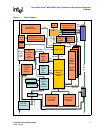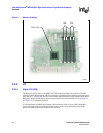
18 Technical Product Specification
Order #273817
Intel NetStructure
®
MPCBL0001 High Performance Single Board Computer
Contents
2.2.1 Low Voltage Intel
®
Xeon
™
Processor CPU-0 (U35), CPU-1
(U36)
The MPCBL0001 SBC supports up to two Low Voltage Intel
®
Xeon™ processors (see Figure 20,
“Component Layout (#1)” on page 100 for locations). The Low Voltage Xeon processor
incorporates Intel
®
NetBurst™ microarchitecture and a high-bandwidth Front-Side Bus, allowing
performance levels that are significantly higher than previous generations of IA-32 family
processors. The processors include the following features:
• 2.0 GHz with a 400 MHz system bus
• 512 Kbyte L2 cache
• Hyper-pipelined technology
• Advanced dynamic execution
• Execution trace cache
• Streaming SIMD (single instruction, multiple data) extensions 2
• Advanced transfer cache
• Enhanced floating point and multimedia engine
• Intel & OEM EEPROM and thermal sensor manageability features
• Supports single and dual processor configurations
• Throttling enabled for protection against high temperatures
The Low Voltage Xeon processor host bus utilizes a split-transaction, deferred-reply protocol. The
host bus uses source-synchronous transfer of address and data to improve throughput at the 100 or
133 MHz bus frequency (depending on processor model). Addresses are transferred at 2X the bus
frequency while data is transferred at 4X the bus frequency, resulting in peak data transfer rates up
to 3.2 or 4.3 GBytes/s.
In addition to the NetBurst microarchitecture, the Low Voltage Intel Xeon processor includes a
groundbreaking technology called Hyper-Threading Technology
†
(HT Technology). HT
Technology improves processor performance for multithreaded applications or multitasking
environments by supporting multiple software threads on each processor.
Low Voltage Intel Xeon processors require their package case temperatures to be operated below
an absolute maximum specification. If the chassis ambient temperature exceeds a level whereby
the processor thermal cooling subsystem can no longer maintain the specified case temperature, the
processors will automatically enter a mode called Thermal Monitor to reduce their case
temperatures. Thermal Monitor controls the processor temperature by modulating the internal
processor core clocks, thereby reducing internal power dissipation, and does not require any
interaction by the Operating System or Application. Once the case temperatures have reached a
safe operating level, the processor will return to its non-modulated operating frequency. See the
Low Voltage Intel Xeon processor datasheet, referenced in Appendix A, “Reference Documents”,
for further details.
An optional ITP700 port connection is included to facilitate debug and BIOS/software
development efforts. This JTAG connection to the processors utilizes voltage-signaling levels that
are specific to the Low Voltage Xeon processor family. These levels must not be exceeded or
processor damage may occur. Please refer to Intel document ITP700 Debug Port Design Guide,
order number 249679-005 for additional information on the ITP connector pin definitions.


















